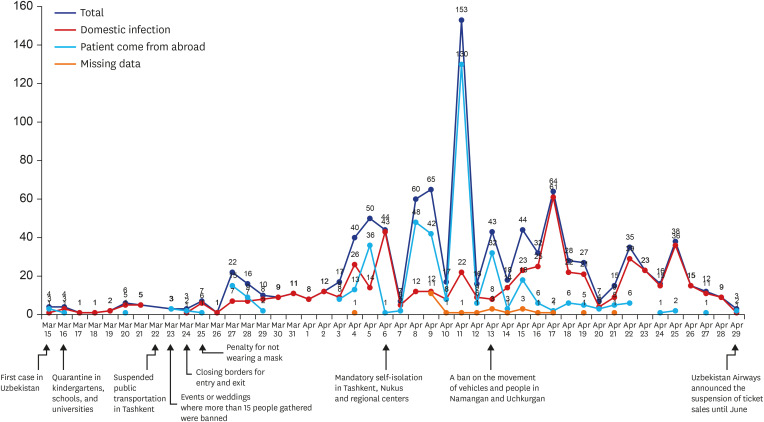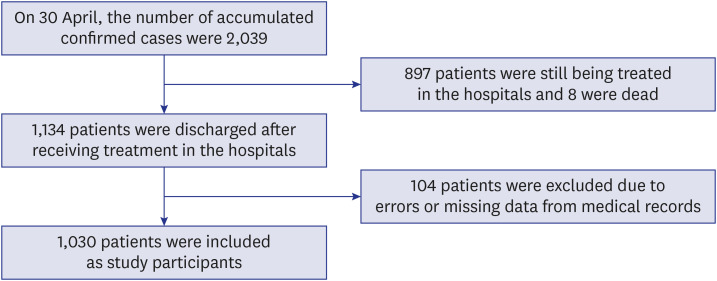J Korean Med Sci.
2020 Nov;35(45):e404. 10.3346/jkms.2020.35.e404.
Clinical Features of COVID-19 in Uzbekistan
- Affiliations
-
- 1Institute for Environmental Health, Korea University, Seoul, Korea
- 2Graduate School of Public Health, Korea University, Seoul, Korea
- 3Department of Preventive Medicine, Korea University College of Medicine, Seoul, Korea
- 4The Tashkent Institute of Postgraduate Medical Education, Tashkent, Uzbekistan
- 5The Tashkent Medical Academy, Tashkent, Uzbekistan
- 6Department of International Development Cooperation, Graduate School of Pan-Pacific International Studies, Kyung Hee University, Seoul, Korea
- KMID: 2508807
- DOI: http://doi.org/10.3346/jkms.2020.35.e404
Abstract
- Background
As of April 30, 2020, a total of 2,039 cases of the novel coronavirus disease 2019 (COVID-19) were confirmed in the Republic of Uzbekistan after the first detection on March 15. Reports on symptoms of COVID-19 are non-specific and known to vary from asymptomatic, mild to severe, or fatal. This study aimed to analyze the symptomatic and clinical characteristics of study participants based on the medical records of participants hospitalized with COVID-19 in Uzbekistan.
Methods
We collected all data from medical records of COVID-19 confirmed patients in 19 hospitals from 13 regions of Uzbekistan between March 15 and April 30. We selected 1,030 patients discharged from the hospitals after COVID-19 treatment as study participants, excluding those with missing data. Further, we collected demographics, symptoms, clinical outcomes, and treatment data through medical records.
Results
More than half (57.6%) of confirmed cases of COVID-19 were males, and the median age was 36.0 years. The most frequent symptoms at the first inspection on hospital admission of all patients were fatigue (59.7%), dry cough (54.1%), pharyngalgia (31.6%), headache (20.6%), and anorexia (12.5%). Compared to the oldest group, the youngest group showed a lower frequency of symptoms. About half of the group aged 18–49 years reported that they came from abroad. One-fifth of patients in group 50–84 received oxygen support, while no patients in group aged 0–17 years received oxygen support. About two-thirds of the participants from intensive care unit (ICU) came from abroad, whereas 42.1% of the non-ICU group returned from other countries. Regarding symptoms, 16.9% of the patients in the ICU group were asymptomatic, while 5.8% in the non-ICU group were asymptomatic.
Conclusion
This study suggests that the medical delivery system and resource distribution need to be implemented based on clinical characteristics by age and severity to delay and effectively respond to the spread of infections in the future. This study analyzed symptoms of COVID-19 patients across Uzbekistan, which is useful as primary data for policies on COVID-19 in Uzbekistan.
Keyword
Figure
Reference
-
1. World Health Organization. Archived: WHO timeline - COVID-19. Updated 2020. Accessed June 4, 2020. https://www.who.int/news-room/detail/27-04-2020-who-timeline---covid-19.2. Cucinotta D, Vanelli M. WHO declares COVID-19 a pandemic. Acta Biomed. 2020; 91(1):157–160. PMID: 32191675.3. World Health Organization. WHO coronavirus disease (COVID-19) dashboard. Updated 2020. Accessed June 30, 2020. https://covid19.who.int/.4. Centers for Disease Control and Prevention. Interim clinical guidance for management of patients with confirmed coronavirus disease (COVID-19). Updated 2020. Accessed June 12, 2020. https://www.cdc.gov/coronavirus/2019-ncov/hcp/clinical-guidance-management-patients.html.5. Wang Y, Wang Y, Chen Y, Qin Q. Unique epidemiological and clinical features of the emerging 2019 novel coronavirus pneumonia (COVID-19) implicate special control measures. J Med Virol. 2020; 92(6):568–576. PMID: 32134116.
Article6. Wang D, Hu B, Hu C, Zhu F, Liu X, Zhang J, et al. Clinical characteristics of 138 hospitalized patients with 2019 novel coronavirus-infected pneumonia in Wuhan, China. JAMA. 2020; 323(11):1061–1069. PMID: 32031570.
Article7. Qiu H, Wu J, Hong L, Luo Y, Song Q, Chen D. Clinical and epidemiological features of 36 children with coronavirus disease 2019 (COVID-19) in Zhejiang, China: an observational cohort study. Lancet Infect Dis. 2020; 20(6):689–696. PMID: 32220650.
Article8. Jang JG, Hur J, Choi EY, Hong KS, Lee W, Ahn JH. Prognostic factors for severe coronavirus disease 2019 in Daegu, Korea. J Korean Med Sci. 2020; 35(23):e209. PMID: 32537954.
Article9. Organization for Economic Cooperation and Development. OECD policy responses to coronavirus (COVID-19): COVID-19 crisis response in Central Asia. Updated 2020. Accessed June 30, 2020. https://www.oecd.org/coronavirus/policy-responses/covid-19-crisis-response-in-central-asia-5305f172/.10. Semenova Y, Glushkova N, Pivina L, Khismetova Z, Zhunussov Y, Sandybaev M, et al. Epidemiological characteristics and forecast of COVID-19 outbreak in the Republic of Kazakhstan. J Korean Med Sci. 2020; 35(24):e227. PMID: 32567261.
Article11. SojuzPravoInform LLC. Order of the president of the Republic of Uzbekistan. Updated 2020. Accessed March 3, 2020. https://cis-legislation.com/document.fwx?rgn=122506.12. Garg S, Kim L, Whitaker M, O'Halloran A, Cummings C, Holstein R, et al. Hospitalization rates and characteristics of patients hospitalized with laboratory-confirmed coronavirus disease 2019 - COVID-NET, 14 States, March 1-30, 2020. MMWR Morb Mortal Wkly Rep. 2020; 69(15):458–464. PMID: 32298251.
Article13. Ministry of Health (UZ). Interim Guidelines for the Management of Patients Infected with COVID-19. 5th ed. Tashkent: Ministry of Health;2020.14. Huang C, Wang Y, Li X, Ren L, Zhao J, Hu Y, et al. Clinical features of patients infected with 2019 novel coronavirus in Wuhan, China. Lancet. 2020; 395(10223):497–506. PMID: 31986264.
Article15. Zeng QL, Li GM, Ji F, Ma SH, Zhang GF, Xu JH, et al. Clinical course and treatment efficacy of COVID-19 near Hubei Province, China: a multicentre, retrospective study. Transbound Emerg Dis. Forthcoming. 2020; DOI: 10.1111/tbed.13674.
Article16. Marcin J. Blood pressure readings explained. Updated 2020. Accessed February 10, 2020. https://www.healthline.com/health/high-blood-pressure-hypertension/blood-pressure-reading-explained#takeaway.17. Cheng AC, Black JF, Buising KL. Respiratory rate: the neglected vital sign. Med J Aust. 2008; 189(9):531.
Article18. UN Women. COVID-19: Emerging gender data and why it matters. Updated 2020. Accessed June 5, 2020. https://data.unwomen.org/resources/covid-19-emerging-gender-data-and-why-it-matters.19. Alsofayan YM, Althunayyan SM, Khan AA, Hakawi AM, Assiri AM. Clinical characteristics of COVID-19 in Saudi Arabia: a national retrospective study. J Infect Public Health. 2020; 13(7):920–925. PMID: 32534945.
Article20. Argenziano MG, Bruce SL, Slater CL, Tiao JR, Baldwin MR, Barr RG, et al. Characterization and clinical course of 1000 patients with coronavirus disease 2019 in New York: retrospective case series. BMJ. 2020; 369:m1996. PMID: 32471884.
Article21. COVID-19 National Emergency Response Center, Epidemiology and Case Management Team, Korea Centers for Disease Control and Prevention. Coronavirus disease-19: the first 7,755 cases in the Republic of Korea. Osong Public Health Res Perspect. 2020; 11(2):85–90. PMID: 32257774.22. Kim ES, Chin BS, Kang CK, Kim NJ, Kang YM, Choi JP, et al. Clinical course and outcomes of patients with severe acute respiratory syndrome coronavirus 2 infection: a preliminary report of the first 28 patients from the Korean cohort study on COVID-19. J Korean Med Sci. 2020; 35(13):e142. PMID: 32242348.
Article23. WHO Regional Office for Europe. Statement – Invest in the overlooked and unsung: build sustainable people-centred long-term care in the wake of COVID-19. Updated 2020. Accessed May 23, 2020. https://www.euro.who.int/en/about-us/regional-director/statements-and-speeches/2020/statement-invest-in-the-overlooked-and-unsung-build-sustainable-people-centred-long-term-care-in-the-wake-of-covid-19.24. Hays J. Families, women and children in Uzbekistan. Updated 2016. Accessed June 21, 2020. http://factsanddetails.com/central-asia/Uzbekistan/sub8_3d/entry-4706.html.25. Gomes MF, Pastore Y Piontti A, Rossi L, Chao D, Longini I, Halloran ME, et al. Assessing the international spreading risk associated with the 2014 West African Ebola Outbreak. PLoS Curr. 2014; 6:ecurrents.outbreaks.cd818f63d40e24aef769dda7df9e0da5. PMID: 25642360.
Article26. Poletto C, Gomes MF, Pastore Y Piontti A, Rossi L, Bioglio L, Chao DL, et al. Assessing the impact of travel restrictions on international spread of the 2014 West African Ebola epidemic. Euro Surveill. 2014; 19(42):20936. PMID: 25358040.
Article27. Gostin LO, Hodge JG Jr. US emergency legal responses to novel coronavirus: balancing public health and civil liberties. JAMA. 2020; 323(12):1131–1132. PMID: 32207808.28. Zhu J, Zhong Z, Ji P, Li H, Li B, Pang J, et al. Clinicopathological characteristics of 8697 patients with COVID-19 in China: a meta-analysis. Fam Med Community Health. 2020; 8(2):e000406. PMID: 32371463.
Article29. Liu X, Zhou H, Zhou Y, Wu X, Zhao Y, Lu Y, et al. Risk factors associated with disease severity and length of hospital stay in COVID-19 patients. J Infect. 2020; 81(1):e95–7. PMID: 32305490.
Article30. CDC COVID-19 Response Team. Coronavirus disease 2019 in children — United States, February 12–April 2, 2020. MMWR Morb Mortal Wkly Rep. 2020; 69(14):422–426. PMID: 32271728.31. Korea Centers for Disease Control and Prevention. Early trend of imported COVID-19 cases in South Korea. Osong Public Health Res Perspect. 2020; 11(3):140–145. PMID: 32528820.32. Government of Canada. COVID-19 signs, symptoms and severity of disease: A clinician guide. Updated 2020. Accessed September 20, 2020. https://www.canada.ca/en/public-health/services/diseases/2019-novel-coronavirus-infection/guidance-documents/signs-symptoms-severity.html.33. Lee JY, Kim HA, Huh K, Hyun M, Rhee JY, Jang S, et al. Risk factors for mortality and respiratory support in elderly patients hospitalized with COVID-19 in Korea. J Korean Med Sci. 2020; 35(23):e223. PMID: 32537957.
Article34. The Royal Children's Hospital Melbourne. Acceptable ranges for physiological variables. Updated 2020. Accessed August 17, 2020. https://www.rch.org.au/clinicalguide/guideline_index/Normal_Ranges_for_Physiological_Variables/.35. ACLS Medical Training. Normal values in children. Updated Year. Accessed September 21, 2020. https://www.aclsmedicaltraining.com/normal-values-in-children/.36. Davies NG, Klepac P, Liu Y, Prem K, Jit M, et al. CMMID COVID-19 working group. Age-dependent effects in the transmission and control of COVID-19 epidemics. Nat Med. 2020; 26(8):1205–1211. PMID: 32546824.
Article37. Sung HK, Kim JY, Heo J, Seo H, Jang YS, Kim H, et al. Clinical course and outcomes of 3,060 patients with coronavirus disease 2019 in Korea, January–May 2020. J Korean Med Sci. 2020; 35(30):e280. PMID: 32743995.
Article38. GISAID. Clade and lineage nomenclature. Updated 2020. Accessed August 27, 2020. https://www.gisaid.org/references/statements-clarifications/clade-and-lineage-nomenclature-aids-in-genomic-epidemiology-of-active-hcov-19-viruses/.39. The Korea Herald. Coronavirus spreading now in Korea has its origin in Europe, US. Updated 2020. Accessed August 30, 2020. http://www.koreaherald.com/view.php?ud=20200706000260.40. Yonhap News Agency. S. Korea detects more of mutated strain of COVID-19 that hit N. America, Europe. Updated 2020. Accessed September 29, 2020. https://en.yna.co.kr/view/AEN20200826008500320.41. Hu Z, Song C, Xu C, Jin G, Chen Y, Xu X, et al. Clinical characteristics of 24 asymptomatic infections with COVID-19 screened among close contacts in Nanjing, China. Sci China Life Sci. 2020; 63(5):706–711. PMID: 32146694.
Article
- Full Text Links
- Actions
-
Cited
- CITED
-
- Close
- Share
- Similar articles
-
- Radiation Safety and Radiologist Working Hours in Uzbekistan
- Clinical implications of coronavirus disease 2019 in neonates
- Clinical features of coronavirus disease 2019 in Korean pediatric patients: a single-center retrospective study
- The Management of Thyroid Disease in COVID-19 Pandemic
- Assessment and Management of Dysphagia during the COVID-19 Pandemic



